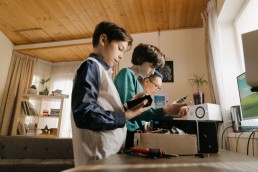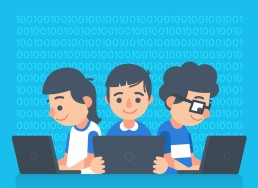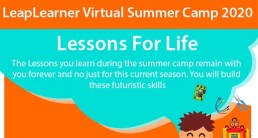Your Child Should Learn Coding but not to become the next Zuckerberg or Pichai
Coding Education for young children is the new buzzword in the Edtech space, and you would often come across Ads which show Bill Gates, Mark Zuckerberg besides an Empty Space, symbolizing if your child can be the next Tech Entrepreneur.
Not only is this misleading, but it’s also highly inappropriate. Indians are known to be great Programmers, and we produce a million of them annually; thanks to thousands of Engineering Colleges which came up during the IT boom at the beginning of this millennium. So why do we need kids to learn Coding at an early age? Do we want to produce more engineers? What about other professionals like Lawyers, Architects, Doctors, Artists, Musicians, and Photographers.
The answer lies in what kids actually learn with ‘Coding classes for Kids in India‘ – Computational Thinking & Algorithmic Intelligence. In Simple terms – the ability to break down a problem in a structured form and use different faculties like Arts, Creativity, Problem Solving to design the solution.
The next key question is – ‘Why do our kids need this; we never learned to code?’ It is pertinent and a great question from a parent’s perspective. After all, they come from all walks of life and are successful without having learned any form of Coding. Had our world not evolved technologically, these questions would be as pertinent as always.
However, our world today is being shaped by Artificial Intelligence – From Edtech to Foodtech to LegalTech and AgriTech; intelligent Technology is driving everything. Imagine a 5-year-old of today, growing on to become a lawyer 20 years down the line. Will the courts and legal transactions remain the same as today? Certainly not. We already have simple things like Stamp Duty and filings moving online. Our elderly, who are not well versed with Computer Technology, struggle to work with basics. In the AI age of tomorrow, a Lawyer would be expected to understand the basics of Computing and the use of AI-driven tools, apart from being an excellent Law Grad.
Medical professionals of the future would be no different. Covid19 Pandemic moved lots of doctors and medical processes online. In the future world 15 years from now, almost all processes from basic tasks like writing prescriptions to elaborate ones like diagnosing complex ailments will be AI-driven. It will be necessary for doctors to understand AI as much as they understand the human body.
A Music Producer friend of mine based out of Los Angeles spoke about his struggles in the world rapidly adopting Intelligent Technology like AI. He says that unlike 12 years ago when he graduated from Music School when the music would be recorded with vocals in a single setting; today music tech is used to sync vocals, instrumentals, and other audio inputs. When he moved to LA from Mumbai, the problem of not understanding Technology dawned on him.
The last and most important question – ‘What and how long to learn?’ Start with tools like Scratch Junior available for Android and iOS. It is a free tool and a great way to introduce your child to Computational Thinking & Algorithmic Intelligence( CTAI). If your child loves what he does on Scratch or Blockly, then sign up for Teacher-Led children’s coding classes for 12-16 hours. For most kids, this exposure clubbed with self-tinkering with Projects would be a tremendous solid foundation in CTAI. It’s as good as some kids excelling in Mathematics and some opting for Non-Mathematics based careers and excelling in it.
And then we always have some students who would want to excel in CTAI and opt for new-age careers in AI, Machine learning & Game Design. For such kids, they should sign up for courses in Python, which is an elementary gateway to Machine Learning.
Certification: This is another popular query. ‘Will my child get a certificate?’ A Certificate is essentially a document that can be shared with a third party to testify that your child has completed and aced a subject matter. Sign up for Courses that allow your child to be assessed on learning outcomes and gives an opportunity to them to get a graded certificate by third party independent authority. In the Indian context, it would be like a CBSE/ICSE/IB board assessing your child at the end of School tenure. Certification by IIT/IIM/Harvard/Booth/Discovery/Google alumni etc. is essentially nothing but a marketing gimmick with no end learning outcome. ( P.S.: I am a Booth Alumni, and I personally do not think that a certificate signed by me would be of any significance )
Rahul Ranjan is the Co-Founder of LeapLearner India. He is a Gold Medalist from NIT Bhopal and a Management grad from Chicago Booth.
A Career entrepreneur, Rahul was the Founder of Alphabyte – India’s first Edtech company focused on Computational Thinking & Algorithmic Intelligence for young children.
Why Block coding is the Best Programming Language for Kids
Introducing your kids to the world of programming and coding can be challenging, especially considering the number of programming languages out there. Most parents who want their kids to gain an interest in computer programming tend to be confused about the preliminary language that will later set the stage for more advanced programming skills. While there are multiple computer languages out there and equally numbered opinions and recommendations for kids to start with, Block coding is the best language for kids to start programming with.
Block coding was created by Mitch Resnik, head of the Lifelong Kindergarten group at the MIT Media Lab. Resnik understands the value of coding and computer literacy in early education, and that’s why he created a computer language that caters especially to children between the age of 5-14.
What makes Block coding the best programming language for kids?
In order to understand why Block coding is best for kids, we must first learn how the programming language works. The latest version of the Block coding, i.e., Block coding 3.0, requires children to drag out code blocks from a drawer (situated on the left side of the screen) and drop it in the center panel. These blocks are arranged in the center panel according to the sequence of code instructions. When running the code, the children can see the results right away in the right panel on the screen. Based on the results, kids can either test their code or develop it further. All of this happens on a visually interactive screen, making it easy to understand and make changes to.
Suggested Read: Most popular programming languages for Kids
Block coding is easy
It is easy because, unlike most programming languages, Block coding does not require one to know syntaxes, symbols, commands, or have necessary coding skills. It is a simple block-based programming language where kids can drag and drop blocks as they want. The order in which they drop the blocks is the order in which the code will execute. Moreover, the shape of the blocks further helps children to understand which block comes when, almost like a game of Tetris.
Suggested Read: Online Coding Course for Kids below 15 years
Block coding is amusing
One of the best aspects of Block coding is that it displays the outcome of the code right away. However the children are arranging the blocks, its output will appear on the screen accordingly. This type of visual confirmation that the code is working or not working correctly helps kids understand the basics of coding in a fun way. Kids learn a lot through visuals, and Block coding is visually interactive, which makes it an amusing language to code with. Moreover, with the recent upgrade, the developers at MIT have added many new features that are sure to capture children’s attention.
Block coding lays the foundation
Block coding is not only easy and fun to play with but also close to advanced coding languages in its features and style. That means when your kids have mastered Block coding, it is easier for them to transition to other languages and not be daunted by them. Its resemblance with other full-feature and full-syntax programming languages such as Python and JavaScript makes it a foundational language for kids to get their hands on.
It is a massive online community
Block coding is used by more than 15 million users worldwide, which means your kids have a chance to interact with other young coders like them and learn from those who are more advanced. Block coding also allows users to save their projects on their servers, allowing newbies to navigate through the great ones and develop a better understanding of how the language works and what can be achieved with it. There is currently a flood of companies providing one to one coding classes for kids.
LeapLearner introduces young coders to Block coding from age 5 onwards. We have found that kids adopt block coding very comfortably and inculcate programming habits with ease. You can request a free demo class and see how block coding can benefit your kids.
Top Three Coding Languages for Your Kids to Learn
As per the experts, in the upcoming 20 years, most of the jobs will be based on Computational Thinking and Algorithmic Intelligence (CTAI), and coding is the foundational skill for CTAI. So, why not introduce your kids to some primary programming language to instill a foundation in them that they can build their career upon. Even if your kids don’t choose to pursue a career in programming, learning the basics of coding makes them more cognitive and an out-of-the-box thinker. As Steve Jobs once said, “Everyone should learn to code because it teaches you how to think.”
But the question is, where can one start? What are some of the introductory languages that kids can get started with? And how does one get their kids to approach such languages?
In this article, we will discuss the top three languages that are best suitable for kids because of their comprehensibility and ease of understanding.
Scratch
Scratch is a block-based programming language that caters primarily to children. It offers a visual approach to programming interactive stories, games, and animations. Scratch insinuates kids to employ logic, creativity, and reasoning while working on coding.
The best thing about Scratch is that it is an introductory approach to teaching your kids coding. Learning from Scratch does not require one to be an expert in programming. Only a sense of enthusiasm and curiosity can make your kids love this programming language. Scratch is easy to understand and code with, thanks to its visual interface. Moreover, it lays a strong foundation and interest in programming and coding so your kids stay curious about what else they can achieve with computer language.
Python
When kids are well-versed in Scratch, the next programming language to introduce to them is Python. Not unlike Scratch, Python is easy to understand, thanks to its use of simple syntaxes. Where most programming languages use complex combinations of symbols and commands, Python relies on straightforward commands.
The language helps kids get familiar with all the necessary programming characteristics while making coding easy and simple. Therefore, when kids have had their hands on Python, they can transition to other, more complex languages without much difficulty. A fun fact about Python is that the world’s biggest video sharing platform, YouTube, uses the language for most of its framework. That proves that Python remains an integral programming language to learn for anyone wanting to become a good coder.
HTML/CSS
HTML and CSS are foundational languages of the web. HTML stands for Hypertext Markup Language, and CSS stands for Cascading Style Sheets. While the former is used to design webpages, the latter is used to define the presentation of a document on the webpage.
Teaching kids HTML and CSS gets them familiar with the basic text-based syntax, using which they can create basic web pages of their own. Like Scratch and Python, HTML/CSS teaches the foundational skills for developing websites, which can later be advanced with Java and PHP.
Moreover, having an idea about HTML and CSS also gives the kids the freedom to create their own website and not be dependent on others to do it for them. Both languages are easy to understand and can be mastered by spending a few hours every day on them.
There are many programming languages out there, some of them difficult, while some are easier to understand. Nevertheless, there must be a starting point for everything, and languages like Scratch, Python, and HTML/CSS serve to be that. They lay the foundation on which one can build their entire programming career. Whether you are looking for your kids to learn programming and code games or animation or simply want them to have an idea of computer languages, make sure you start with the basics.
LeapLearner Virtual Summer Camp 2020
Lessons For Life
The Lessons you learn during the summer camp remain with you forever and no just for this current season. You will build these futuristic skills
- Identifying real-life problems
- Ideate creative solutions
- Collaborate with international students
- Learn how to use coding, robotics for your solution
Utilize the LockDown
In the times of COVID 19 Pandemic where our children are stuck at home, we would like them to continue learning with our online Virtual Summer Camp, The most loved program by kids.
One to One Online Classes and Group Online Classes Available in Block Coding for Kids, Python Programming for Kids, Robotics & AI training for Holidays, App Development for Kids
Visit us at: https://leaplearner.in/vsc | Email: info@leaplearner.in | Contact: 8527321859
PROGRAMS IN OUR SUMMER CAMP
Coding – App Development – Robotics
Who Can Participate?
The Virtual Summer camp is designed for ages 5-14 years.
LeapLearner Summer Camp Advantage
- Gaining a strong foundation in Computational Thinking & Algorithmic Intelligence
- Opportunities to collaborate with other students
- Use code to transform new ideas into games, puzzles, and apps
- Certification from iCode.org, a global non-profit and international leader in coding education
Visit us at: https://leaplearner.in/vsc
Email: info@leaplearner.in
Contact: 8527321859




